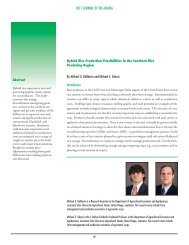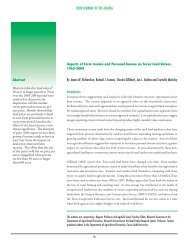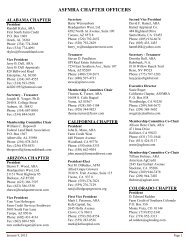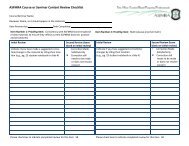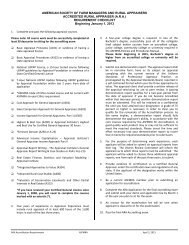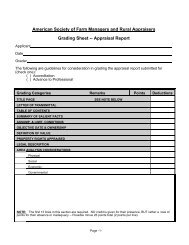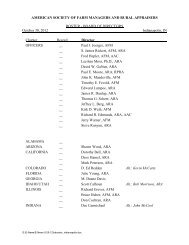Sharing Financial Risk through Flexible Farm Lease Agreements
Sharing Financial Risk through Flexible Farm Lease Agreements
Sharing Financial Risk through Flexible Farm Lease Agreements
Create successful ePaper yourself
Turn your PDF publications into a flip-book with our unique Google optimized e-Paper software.
2013 JOURNAL OF THE ASFMRA<br />
described earlier. For example, the probability of a<br />
loss under a fixed cash lease was 51 percent.<br />
Incorporating yield variability into the rent formula<br />
(Types 1 and 2) had little effect on the probability<br />
of a loss for the tenant, while incorporating price<br />
variability (Types 3 and 4) reduced it some, and<br />
incorporating both price and yield variability<br />
(Types 5, 6 and 7) reduced it even more, to about 45<br />
percent. Shifting to a base rent plus a bonus (Type 8)<br />
further reduced the chances of a loss to 41 percent,<br />
and basing the bonus on revenue earned in excess<br />
of production costs (Type 9) lowered the odds to<br />
only 37 percent, actually lower than the probability<br />
of a loss under a 50-50 crop share lease (39%).<br />
Reducing the minimum cash rent to $150 and $100<br />
for Types 8 and 9, respectively, helped turn some of<br />
the loss years into profitable years for the tenant.<br />
Value at <strong>Risk</strong><br />
Another way to look at the effect of the terms of the<br />
lease on the tenant’s financial risk is to look at the<br />
projected value for profit at the tenth percentile of<br />
the whole profit distribution. In other words, what<br />
is the value that profit will exceed 90 percent of the<br />
time and be less than 10 percent of the time? This<br />
is commonly called “value at risk.” A similar value at<br />
risk could be calculated for other percentile points<br />
of the profit distribution. For example, the fiftieth<br />
percentile value at risk would indicate the level<br />
where half the time profits are higher and half the<br />
time profits are lower.<br />
Table 5 summarizes the tenth percentile value at<br />
risk for the tenant and the landowner for each type<br />
of lease. Higher profits or smaller losses indicate<br />
less financial risk. Not surprisingly, the tenant’s<br />
projected profit in the ninth worst year out of 10<br />
was negative under all the agreements except the<br />
custom farming. The landowner, on the other hand,<br />
showed a positive profit under all the cash rent<br />
alternatives. The owner’s costs were assumed to be<br />
only $40 per acre for real estate taxes and upkeep,<br />
however, and did not include any debt servicing or<br />
returns to equity capital. The profits accruing to the<br />
tenant and the landowner should not be compared<br />
directly to each other, because the two parties<br />
are contributing quite different resources to the<br />
agreement.<br />
The lease types that incorporate both prices and<br />
yields into the rent formulas (Types 5, 7, 9, and 10)<br />
had the smallest losses for the tenant in the ninth<br />
worst year out of ten. On the other hand, Type 6<br />
and Type 8, which both called for a minimum rent<br />
of $150, resulted in larger losses for the tenant in<br />
years of low gross revenue. Type 9 had a minimum<br />
rent of only $100, and Types 5, 7, and 10 had no<br />
minimum rents, which decreased the chances of a<br />
large loss.<br />
Of course less risk for the tenant leads to more risk<br />
for the landowner, as can be seen in the second<br />
column of Table 5. The lowest estimated 10 percent<br />
values at risk for the landowner were for the leases<br />
that had no minimum rent (Types 3, 4, 5, 9, and 10),<br />
and were in the range of $60 to $65 for each one.<br />
The crop share lease about broke even at the tenth<br />
percentile, and the custom farming agreement<br />
projected a loss of $128 per acre for the landowner.<br />
Summary<br />
<strong>Flexible</strong> cash leases are an effective way to share<br />
yield, price, and cost risks between farm tenants<br />
160



